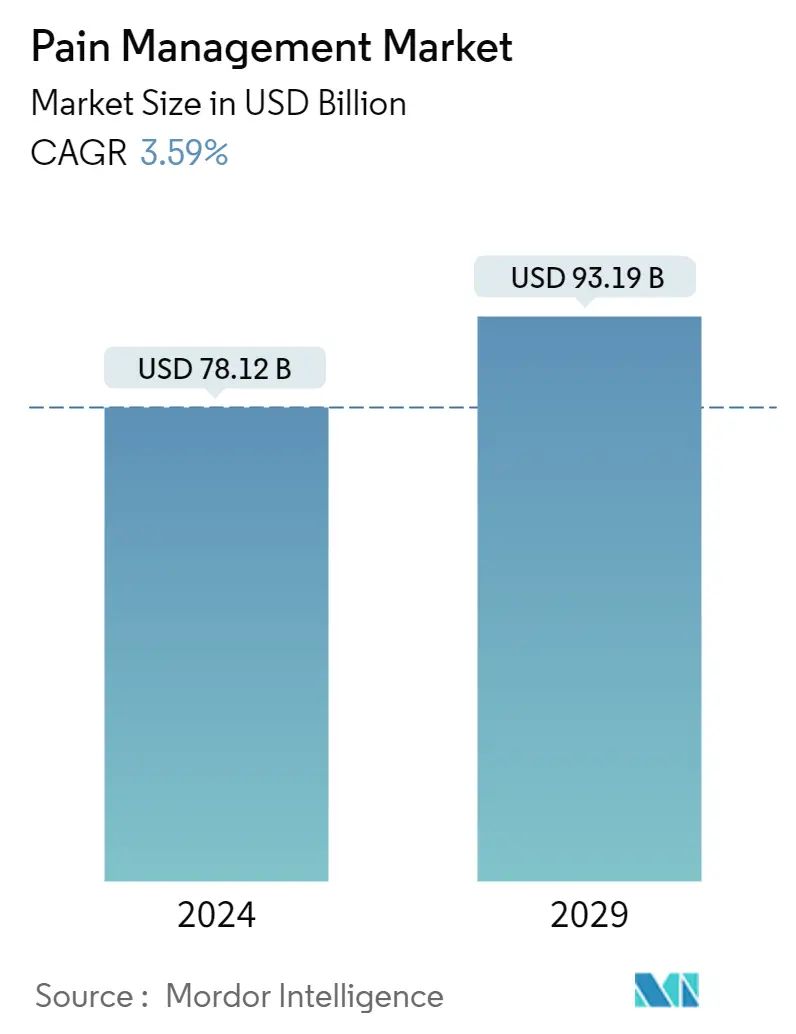Market Size of Pain Management Industry

| Study Period | 2019 - 2029 |
| Market Size (2024) | USD 78.12 Billion |
| Market Size (2029) | USD 93.19 Billion |
| CAGR (2024 - 2029) | 3.59 % |
| Fastest Growing Market | Asia Pacific |
| Largest Market | North America |
| Market Concentration | Medium |
Major Players
*Disclaimer: Major Players sorted in no particular order |
Pain Management Market Analysis
The Pain Management Market size is estimated at USD 78.12 billion in 2024, and is expected to reach USD 93.19 billion by 2029, growing at a CAGR of 3.59% during the forecast period (2024-2029).
The COVID-19 pandemic has impacted healthcare systems across the world. Health agencies were involved in containing coronavirus transmission through lockdown norms, and most elective and non-urgent surgeries were postponed globally. As per the Indian Journal of Anaesthesia 2020, COVID-19 negatively impacted pain clinics, including interventional pain management procedures. The Indian Society of Anaesthesiologists also published guidelines on anesthesia and intensive care practices. Also, the Journal of Pain Medicine suggested that epidural nonsteroid injections for radicular pain can be considered in patients who are already immunosuppressed and at high risk of SARS-CoV-2 infection and complications. As per the April 2022 data published by PubMed, it was observed that people across the United States and Canada suffering from chronic pain witnessed a significant increase in pain during the pandemic. However, following the pandemic, effective pain management is practiced among people suffering from chronic pain, as restrictions on non-essential hospital visits are lifted. Hence, it is observed that the current market has reached a pre-pandemic nature.
The well-established business of using painkiller medications as the first line of treatment has significantly contributed to the growth of the pain management market. However, in recent years, the growing reliance on their long-term use, as well as a better understanding of their side effects, has led to an increase in the use of device-based pain management therapies. Post-operative pain is one of the most common. The cost of monitoring and treating adverse effects creates a significant demand for pain management drugs and devices.
The current market is gradually adopting more non-opioid medications to suppress the addiction to opioids and other well-established painkillers on the market. Several non-opioid drugs with mechanisms of action are currently in the early and late stages of development. The regulatory authorities in multiple countries are shifting to alternative approaches, thus fast-tracking those drugs to market approval. The shift is expected to be gradual. Thus, pain management has desirable growth prospects during the forecast period.
The increasing aging population globally is expected to drive the market's growth, as the prevalence of chronic pain is relatively high among the geriatric population and is considered an independent risk factor for mortality. The increasing number of product launches is also expected to drive the market. For instance, in Octover 2021, Esteve Pharmaceuticals received approval from the US FDA for SEGLENTIS (celecoxib and tramadol hydrochloride) for the management of acute pain in adults that is severe enough to require an opioid analgesic and for which alternative treatments are inadequate. Thus, due to such factors, the pain management market is expected to grow significantly over the forecast period.
However, high procedural and purchase costs of pain management devices can restrain the market's growth.
Pain Management Industry Segmentation
Pain is an unpleasant sensation in the body due to ongoing or impending tissue damage. Pain management includes therapies, drugs, and devices that help alleviate the pain. The pain management market is segmented by mode of pain management (drugs and devices), drugs is further sub-segmented by (opioids and non-narcotic analgesics), and non-narcotic is sub-sub-segmented by (non-steroidal anti-inflammatory drugs, anesthetics, anticonvulsants, anti-depressants, and other non-narcotic analgesics), devices is sub-segmented by (neurostimulation devices and analgesic infusion pumps), neurostimulation devices is sub-sub-segmented by (transcutaneous electrical nerve stimulation devices and brain and spinal cord stimulation devices), and analgesics infusion pumps is sub-sub-segmented by (intrathecal infusion pumps and external infusion pumps), by application (neuropathic pain, cancer pain, facial pain and migraine, musculoskeletal pain, and other applications), and geography (North America, Europe, Asia-Pacific, the Middle East and Africa, and South America). The market report also covers the estimated market sizes and trends for 17 different countries across major regions globally. The report offers the value (in USD million) for the above segments.
| BY Mode of Pain Management | ||||||||||
| ||||||||||
|
| By Application | |
| Neuropathic Pain | |
| Cancer Pain | |
| Facial Pain and Migraine | |
| Musculoskeletal Pain | |
| Other Applications |
| Geography | ||||||||
| ||||||||
| ||||||||
| ||||||||
| ||||||||
|
Pain Management Market Size Summary
The pain management market is poised for significant growth, driven by a combination of factors including the increasing prevalence of chronic pain conditions and the aging global population. The market is experiencing a shift towards non-opioid medications and device-based therapies, as there is a growing awareness of the long-term side effects associated with traditional painkillers. This transition is supported by regulatory authorities fast-tracking the approval of new non-opioid drugs, which are currently in various stages of development. The market's recovery to pre-pandemic levels is evident as restrictions on non-essential hospital visits have been lifted, allowing for the resumption of pain management procedures. The high prevalence of conditions such as migraines and the rising burden of cancer-related pain further contribute to the market's expansion, with new product launches enhancing the available therapeutic options.
North America, particularly the United States, holds a dominant position in the pain management market, fueled by a robust demand for long-term pain management solutions among the elderly and ongoing advancements in pain management technologies. The competitive landscape is marked by the presence of major players like Abbott Laboratories, Johnson & Johnson, and Boston Scientific Corporation, who are actively engaging in strategic partnerships and product innovations to maintain their market positions. The market's growth is also supported by the increasing number of product approvals and the establishment of comprehensive pain management services. Despite the high costs associated with pain management devices, the market is expected to continue its upward trajectory, driven by the persistent demand for effective pain relief solutions.
Pain Management Market Size - Table of Contents
-
1. MARKET DYNAMICS
-
1.1 Market Overview
-
1.2 Market Drivers
-
1.2.1 Increasing Demand for Long-term Pain Management from the Geriatric Population
-
1.2.2 Proven Efficacy of Pain Management Devices for the Treatment of Chronic Pain
-
1.2.3 Development of Novel Pain Management Devices and Techniques
-
-
1.3 Market Restraints
-
1.3.1 Lack of Awareness About the Availability and Use of Pain Management Devices
-
1.3.2 High Procedural and Purchase Cost of Pain Management Devices
-
-
1.4 Porter's Five Forces Analysis
-
1.4.1 Threat of New Entrants
-
1.4.2 Bargaining Power of Buyers/Consumers
-
1.4.3 Bargaining Power of Suppliers
-
1.4.4 Threat of Substitute Products
-
1.4.5 Intensity of Competitive Rivalry
-
-
-
2. MARKET SEGMENTATION (Market Size by Value - USD million)
-
2.1 BY Mode of Pain Management
-
2.1.1 Drugs
-
2.1.1.1 Opioids
-
2.1.1.2 Non-narcotic Analgesics
-
2.1.1.2.1 Non-Steroidal Anti-Inflammatory Drugs (NSAIDs)
-
2.1.1.2.2 Anesthetics
-
2.1.1.2.3 Anticonvulsants
-
2.1.1.2.4 Anti-depressants
-
2.1.1.2.5 Other Non-narcotic Analgesics
-
-
-
2.1.2 Devices
-
2.1.2.1 Neurostimulation Devices
-
2.1.2.1.1 Transcutaneous Electrical Nerve Stimulation (TENS) Devices
-
2.1.2.1.2 Brain and Spinal Cord Stimulation (SCS) Devices
-
-
2.1.2.2 Analgesic Infusion Pumps
-
2.1.2.2.1 Intrathecal Infusion Pumps
-
2.1.2.2.2 External Infusion Pumps
-
-
-
-
2.2 By Application
-
2.2.1 Neuropathic Pain
-
2.2.2 Cancer Pain
-
2.2.3 Facial Pain and Migraine
-
2.2.4 Musculoskeletal Pain
-
2.2.5 Other Applications
-
-
2.3 Geography
-
2.3.1 North America
-
2.3.1.1 United States
-
2.3.1.2 Canada
-
2.3.1.3 Mexico
-
-
2.3.2 Europe
-
2.3.2.1 Germany
-
2.3.2.2 United Kingdom
-
2.3.2.3 France
-
2.3.2.4 Italy
-
2.3.2.5 Spain
-
2.3.2.6 Rest of Europe
-
-
2.3.3 Asia-Pacific
-
2.3.3.1 China
-
2.3.3.2 Japan
-
2.3.3.3 India
-
2.3.3.4 Australia
-
2.3.3.5 South Korea
-
2.3.3.6 Rest of Asia-Pacific
-
-
2.3.4 Middle East and Africa
-
2.3.4.1 GCC
-
2.3.4.2 South Africa
-
2.3.4.3 Rest of Middle East and Africa
-
-
2.3.5 South America
-
2.3.5.1 Brazil
-
2.3.5.2 Argentina
-
2.3.5.3 Rest of South America
-
-
-
Pain Management Market Size FAQs
How big is the Pain Management Market?
The Pain Management Market size is expected to reach USD 78.12 billion in 2024 and grow at a CAGR of 3.59% to reach USD 93.19 billion by 2029.
What is the current Pain Management Market size?
In 2024, the Pain Management Market size is expected to reach USD 78.12 billion.

